Analysis of Deteriorating Patient: Mr. Orkins' Case and Nursing Plan
VerifiedAdded on 2021/02/19
|9
|1807
|28
Report
AI Summary
This report presents a case study of Mr. Orkins, an 84-year-old male patient experiencing deteriorating health. The report details the patient's medical condition, including subjective and objective cues gathered through primary, secondary, and focused assessments. It outlines the patient's slurred speech, drooling, unresponsiveness, and abnormal vital signs such as increased blood pressure, heart rate, and respiratory rate. The report then discusses the methods used for conducting these assessments, focusing on analyzing patient behavior and vital signs. Finally, it proposes a comprehensive nursing care plan, including nursing diagnoses, interventions, rationales, and expected outcomes, to address Mr. Orkins' critical condition and promote improved health outcomes. The report concludes by emphasizing the importance of nursing interventions in providing effective patient care and safety.
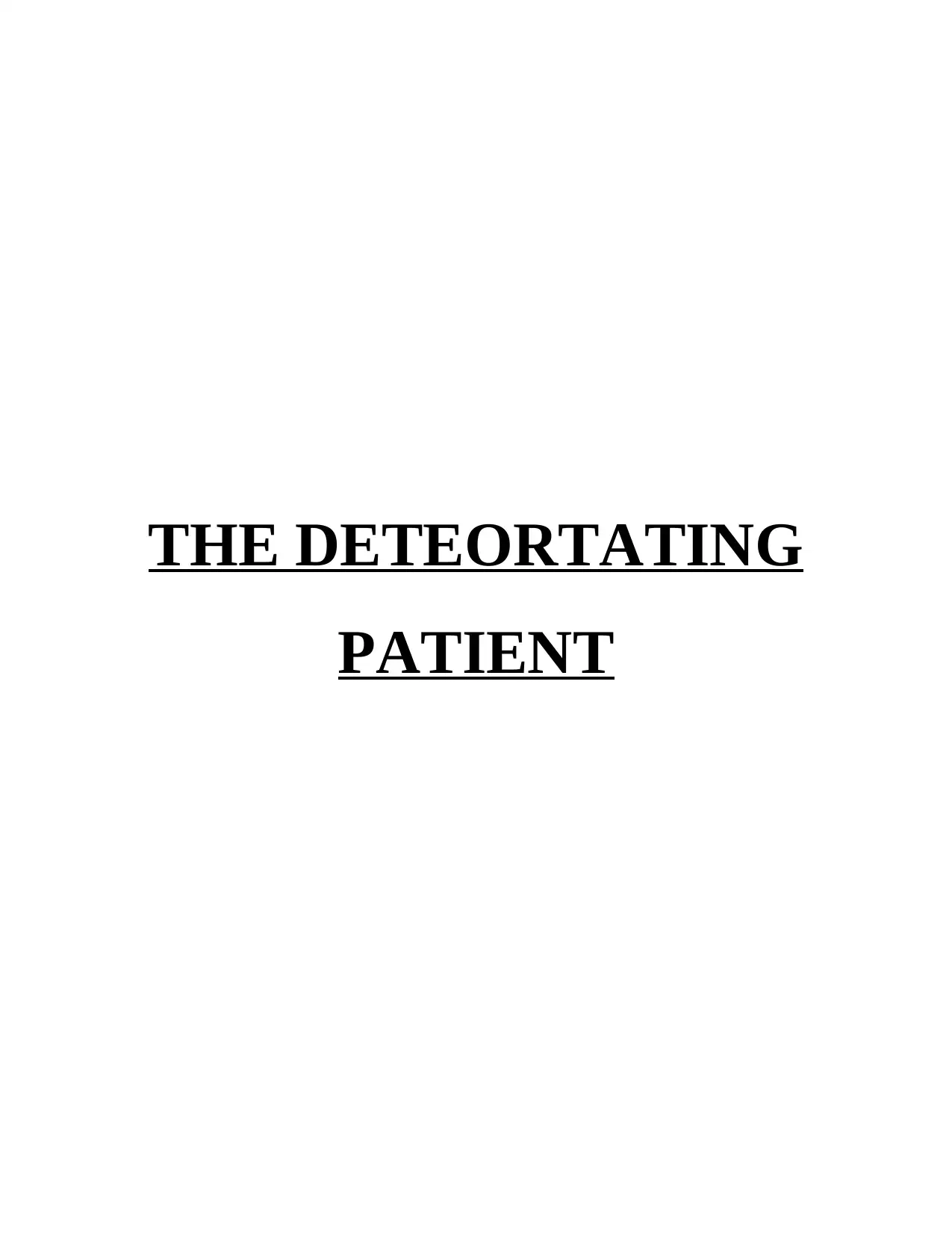
THE DETEORTATING
PATIENT
PATIENT
Paraphrase This Document
Need a fresh take? Get an instant paraphrase of this document with our AI Paraphraser
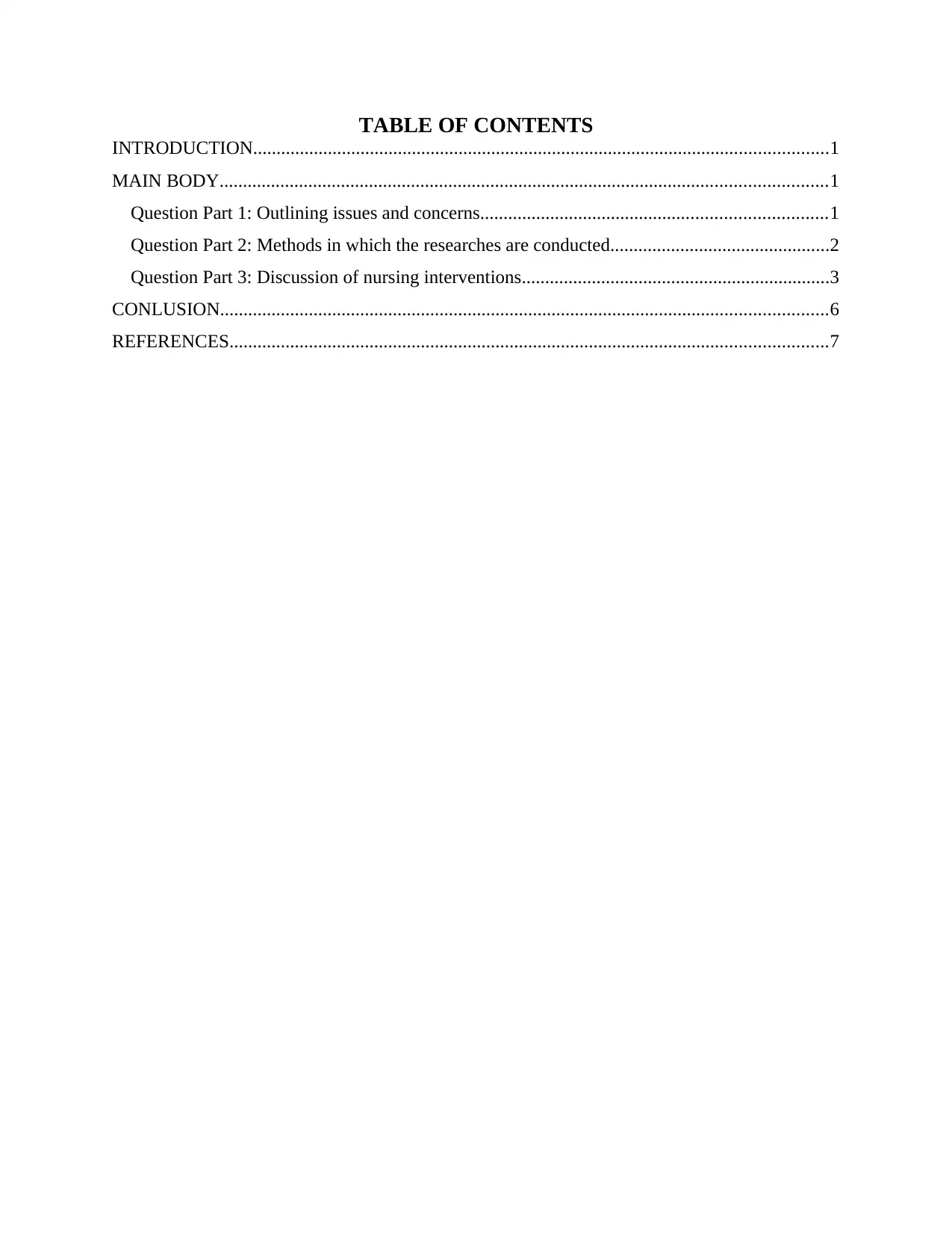
TABLE OF CONTENTS
INTRODUCTION...........................................................................................................................1
MAIN BODY..................................................................................................................................1
Question Part 1: Outlining issues and concerns..........................................................................1
Question Part 2: Methods in which the researches are conducted...............................................2
Question Part 3: Discussion of nursing interventions..................................................................3
CONLUSION..................................................................................................................................6
REFERENCES................................................................................................................................7
INTRODUCTION...........................................................................................................................1
MAIN BODY..................................................................................................................................1
Question Part 1: Outlining issues and concerns..........................................................................1
Question Part 2: Methods in which the researches are conducted...............................................2
Question Part 3: Discussion of nursing interventions..................................................................3
CONLUSION..................................................................................................................................6
REFERENCES................................................................................................................................7
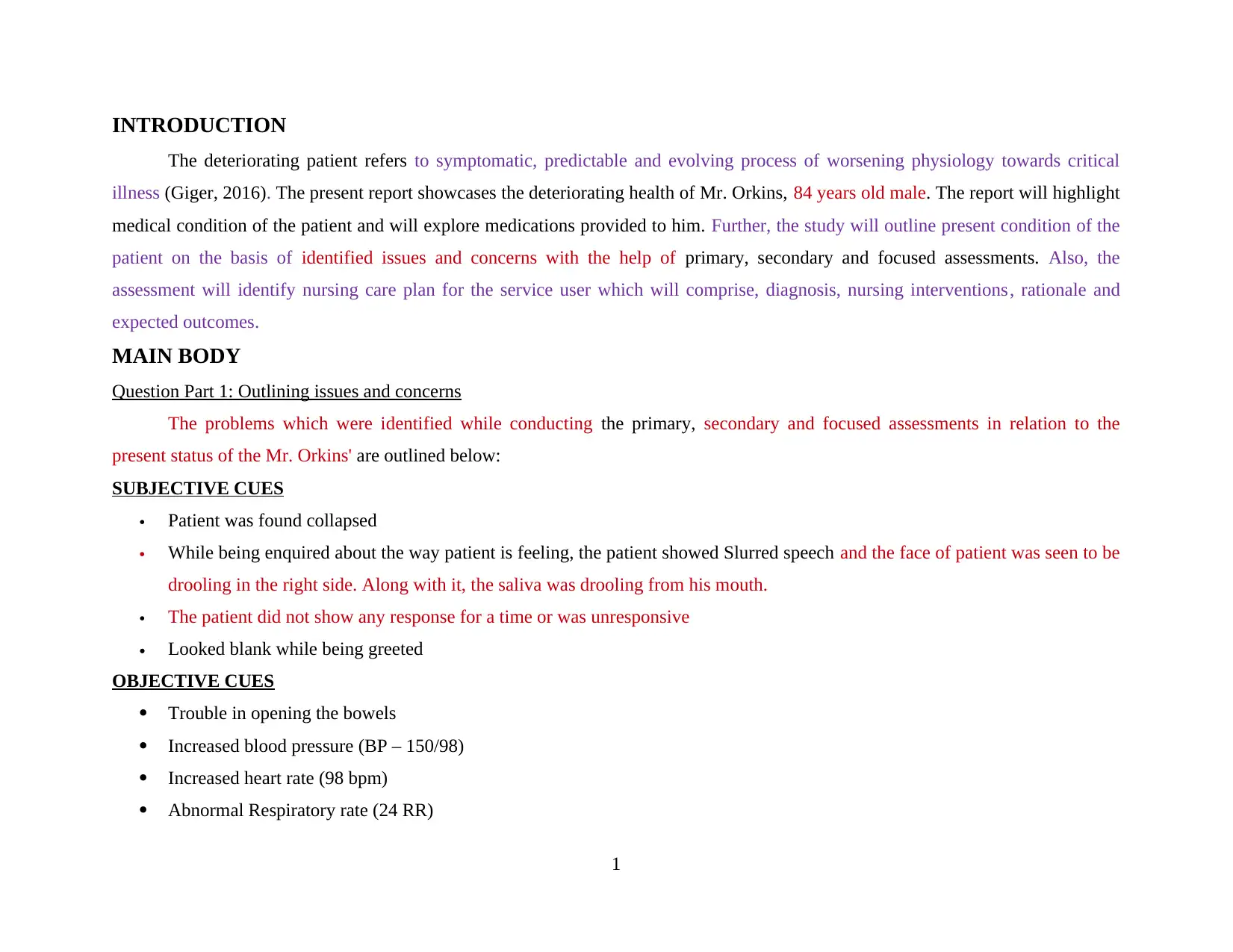
INTRODUCTION
The deteriorating patient refers to symptomatic, predictable and evolving process of worsening physiology towards critical
illness (Giger, 2016). The present report showcases the deteriorating health of Mr. Orkins, 84 years old male. The report will highlight
medical condition of the patient and will explore medications provided to him. Further, the study will outline present condition of the
patient on the basis of identified issues and concerns with the help of primary, secondary and focused assessments. Also, the
assessment will identify nursing care plan for the service user which will comprise, diagnosis, nursing interventions, rationale and
expected outcomes.
MAIN BODY
Question Part 1: Outlining issues and concerns
The problems which were identified while conducting the primary, secondary and focused assessments in relation to the
present status of the Mr. Orkins' are outlined below:
SUBJECTIVE CUES
Patient was found collapsed
While being enquired about the way patient is feeling, the patient showed Slurred speech and the face of patient was seen to be
drooling in the right side. Along with it, the saliva was drooling from his mouth.
The patient did not show any response for a time or was unresponsive
Looked blank while being greeted
OBJECTIVE CUES
Trouble in opening the bowels
Increased blood pressure (BP – 150/98)
Increased heart rate (98 bpm)
Abnormal Respiratory rate (24 RR)
1
The deteriorating patient refers to symptomatic, predictable and evolving process of worsening physiology towards critical
illness (Giger, 2016). The present report showcases the deteriorating health of Mr. Orkins, 84 years old male. The report will highlight
medical condition of the patient and will explore medications provided to him. Further, the study will outline present condition of the
patient on the basis of identified issues and concerns with the help of primary, secondary and focused assessments. Also, the
assessment will identify nursing care plan for the service user which will comprise, diagnosis, nursing interventions, rationale and
expected outcomes.
MAIN BODY
Question Part 1: Outlining issues and concerns
The problems which were identified while conducting the primary, secondary and focused assessments in relation to the
present status of the Mr. Orkins' are outlined below:
SUBJECTIVE CUES
Patient was found collapsed
While being enquired about the way patient is feeling, the patient showed Slurred speech and the face of patient was seen to be
drooling in the right side. Along with it, the saliva was drooling from his mouth.
The patient did not show any response for a time or was unresponsive
Looked blank while being greeted
OBJECTIVE CUES
Trouble in opening the bowels
Increased blood pressure (BP – 150/98)
Increased heart rate (98 bpm)
Abnormal Respiratory rate (24 RR)
1
⊘ This is a preview!⊘
Do you want full access?
Subscribe today to unlock all pages.

Trusted by 1+ million students worldwide
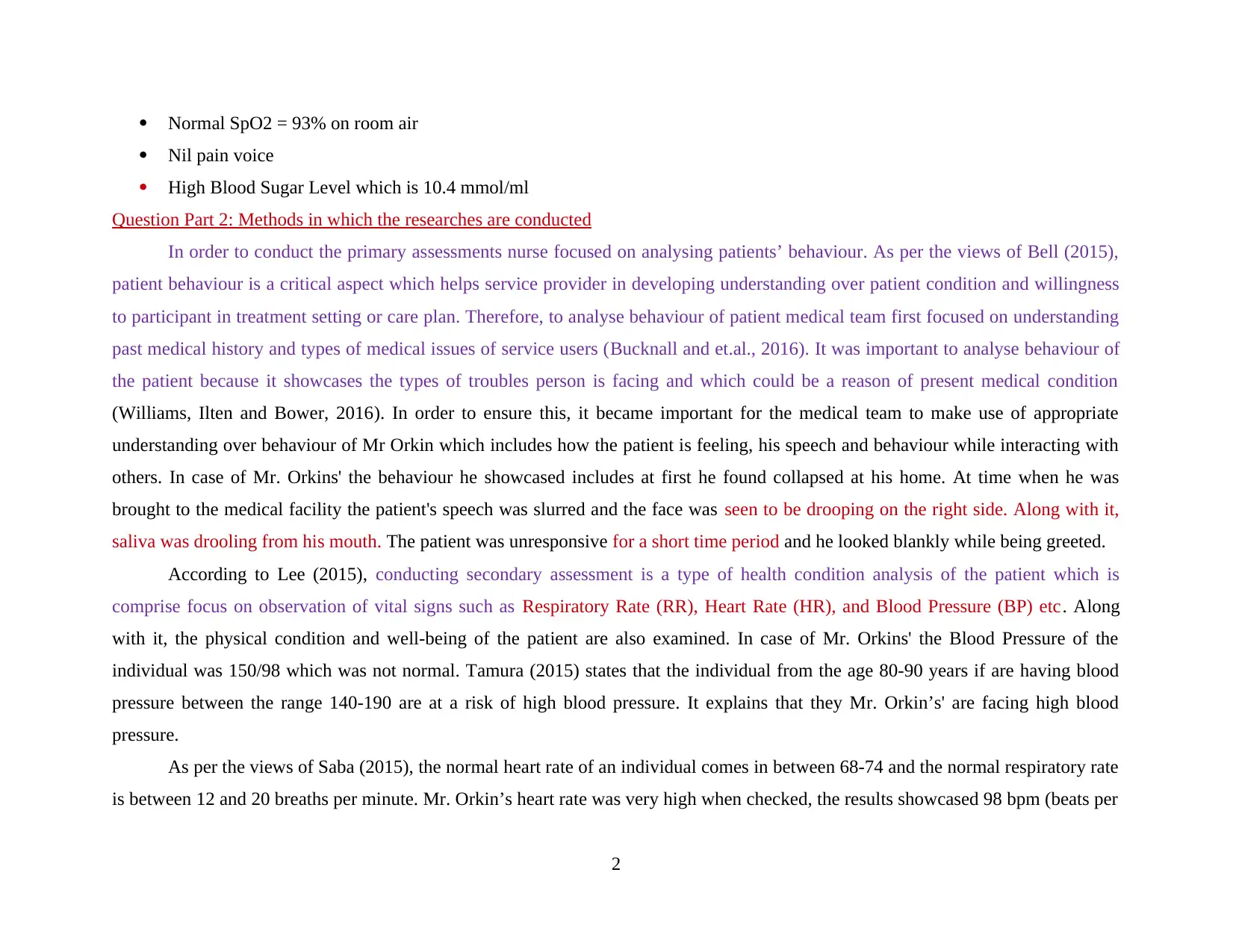
Normal SpO2 = 93% on room air
Nil pain voice
High Blood Sugar Level which is 10.4 mmol/ml
Question Part 2: Methods in which the researches are conducted
In order to conduct the primary assessments nurse focused on analysing patients’ behaviour. As per the views of Bell (2015),
patient behaviour is a critical aspect which helps service provider in developing understanding over patient condition and willingness
to participant in treatment setting or care plan. Therefore, to analyse behaviour of patient medical team first focused on understanding
past medical history and types of medical issues of service users (Bucknall and et.al., 2016). It was important to analyse behaviour of
the patient because it showcases the types of troubles person is facing and which could be a reason of present medical condition
(Williams, Ilten and Bower, 2016). In order to ensure this, it became important for the medical team to make use of appropriate
understanding over behaviour of Mr Orkin which includes how the patient is feeling, his speech and behaviour while interacting with
others. In case of Mr. Orkins' the behaviour he showcased includes at first he found collapsed at his home. At time when he was
brought to the medical facility the patient's speech was slurred and the face was seen to be drooping on the right side. Along with it,
saliva was drooling from his mouth. The patient was unresponsive for a short time period and he looked blankly while being greeted.
According to Lee (2015), conducting secondary assessment is a type of health condition analysis of the patient which is
comprise focus on observation of vital signs such as Respiratory Rate (RR), Heart Rate (HR), and Blood Pressure (BP) etc. Along
with it, the physical condition and well-being of the patient are also examined. In case of Mr. Orkins' the Blood Pressure of the
individual was 150/98 which was not normal. Tamura (2015) states that the individual from the age 80-90 years if are having blood
pressure between the range 140-190 are at a risk of high blood pressure. It explains that they Mr. Orkin’s' are facing high blood
pressure.
As per the views of Saba (2015), the normal heart rate of an individual comes in between 68-74 and the normal respiratory rate
is between 12 and 20 breaths per minute. Mr. Orkin’s heart rate was very high when checked, the results showcased 98 bpm (beats per
2
Nil pain voice
High Blood Sugar Level which is 10.4 mmol/ml
Question Part 2: Methods in which the researches are conducted
In order to conduct the primary assessments nurse focused on analysing patients’ behaviour. As per the views of Bell (2015),
patient behaviour is a critical aspect which helps service provider in developing understanding over patient condition and willingness
to participant in treatment setting or care plan. Therefore, to analyse behaviour of patient medical team first focused on understanding
past medical history and types of medical issues of service users (Bucknall and et.al., 2016). It was important to analyse behaviour of
the patient because it showcases the types of troubles person is facing and which could be a reason of present medical condition
(Williams, Ilten and Bower, 2016). In order to ensure this, it became important for the medical team to make use of appropriate
understanding over behaviour of Mr Orkin which includes how the patient is feeling, his speech and behaviour while interacting with
others. In case of Mr. Orkins' the behaviour he showcased includes at first he found collapsed at his home. At time when he was
brought to the medical facility the patient's speech was slurred and the face was seen to be drooping on the right side. Along with it,
saliva was drooling from his mouth. The patient was unresponsive for a short time period and he looked blankly while being greeted.
According to Lee (2015), conducting secondary assessment is a type of health condition analysis of the patient which is
comprise focus on observation of vital signs such as Respiratory Rate (RR), Heart Rate (HR), and Blood Pressure (BP) etc. Along
with it, the physical condition and well-being of the patient are also examined. In case of Mr. Orkins' the Blood Pressure of the
individual was 150/98 which was not normal. Tamura (2015) states that the individual from the age 80-90 years if are having blood
pressure between the range 140-190 are at a risk of high blood pressure. It explains that they Mr. Orkin’s' are facing high blood
pressure.
As per the views of Saba (2015), the normal heart rate of an individual comes in between 68-74 and the normal respiratory rate
is between 12 and 20 breaths per minute. Mr. Orkin’s heart rate was very high when checked, the results showcased 98 bpm (beats per
2
Paraphrase This Document
Need a fresh take? Get an instant paraphrase of this document with our AI Paraphraser
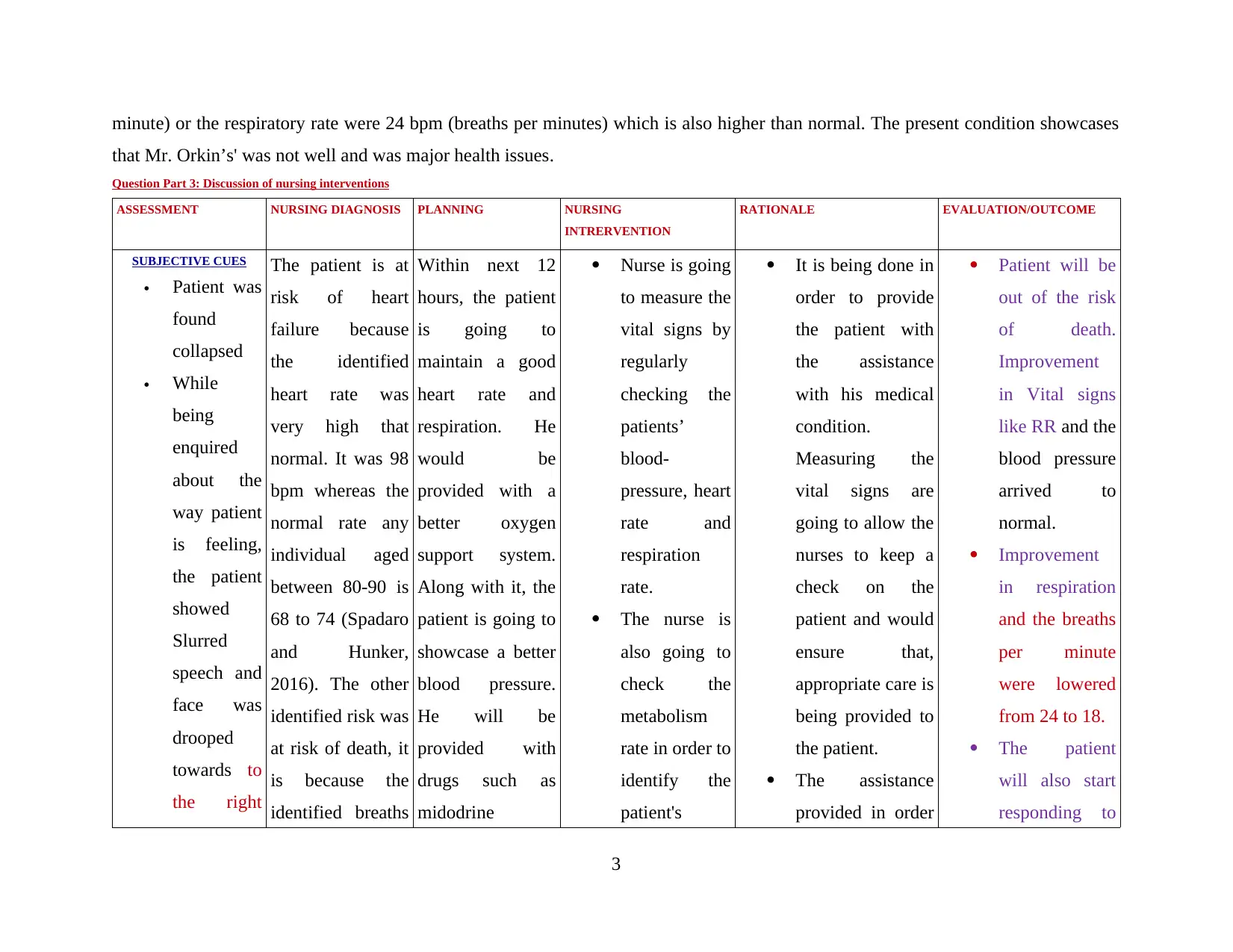
minute) or the respiratory rate were 24 bpm (breaths per minutes) which is also higher than normal. The present condition showcases
that Mr. Orkin’s' was not well and was major health issues.
Question Part 3: Discussion of nursing interventions
ASSESSMENT NURSING DIAGNOSIS PLANNING NURSING
INTRERVENTION
RATIONALE EVALUATION/OUTCOME
SUBJECTIVE CUES
Patient was
found
collapsed
While
being
enquired
about the
way patient
is feeling,
the patient
showed
Slurred
speech and
face was
drooped
towards to
the right
The patient is at
risk of heart
failure because
the identified
heart rate was
very high that
normal. It was 98
bpm whereas the
normal rate any
individual aged
between 80-90 is
68 to 74 (Spadaro
and Hunker,
2016). The other
identified risk was
at risk of death, it
is because the
identified breaths
Within next 12
hours, the patient
is going to
maintain a good
heart rate and
respiration. He
would be
provided with a
better oxygen
support system.
Along with it, the
patient is going to
showcase a better
blood pressure.
He will be
provided with
drugs such as
midodrine
Nurse is going
to measure the
vital signs by
regularly
checking the
patients’
blood-
pressure, heart
rate and
respiration
rate.
The nurse is
also going to
check the
metabolism
rate in order to
identify the
patient's
It is being done in
order to provide
the patient with
the assistance
with his medical
condition.
Measuring the
vital signs are
going to allow the
nurses to keep a
check on the
patient and would
ensure that,
appropriate care is
being provided to
the patient.
The assistance
provided in order
Patient will be
out of the risk
of death.
Improvement
in Vital signs
like RR and the
blood pressure
arrived to
normal.
Improvement
in respiration
and the breaths
per minute
were lowered
from 24 to 18.
The patient
will also start
responding to
3
that Mr. Orkin’s' was not well and was major health issues.
Question Part 3: Discussion of nursing interventions
ASSESSMENT NURSING DIAGNOSIS PLANNING NURSING
INTRERVENTION
RATIONALE EVALUATION/OUTCOME
SUBJECTIVE CUES
Patient was
found
collapsed
While
being
enquired
about the
way patient
is feeling,
the patient
showed
Slurred
speech and
face was
drooped
towards to
the right
The patient is at
risk of heart
failure because
the identified
heart rate was
very high that
normal. It was 98
bpm whereas the
normal rate any
individual aged
between 80-90 is
68 to 74 (Spadaro
and Hunker,
2016). The other
identified risk was
at risk of death, it
is because the
identified breaths
Within next 12
hours, the patient
is going to
maintain a good
heart rate and
respiration. He
would be
provided with a
better oxygen
support system.
Along with it, the
patient is going to
showcase a better
blood pressure.
He will be
provided with
drugs such as
midodrine
Nurse is going
to measure the
vital signs by
regularly
checking the
patients’
blood-
pressure, heart
rate and
respiration
rate.
The nurse is
also going to
check the
metabolism
rate in order to
identify the
patient's
It is being done in
order to provide
the patient with
the assistance
with his medical
condition.
Measuring the
vital signs are
going to allow the
nurses to keep a
check on the
patient and would
ensure that,
appropriate care is
being provided to
the patient.
The assistance
provided in order
Patient will be
out of the risk
of death.
Improvement
in Vital signs
like RR and the
blood pressure
arrived to
normal.
Improvement
in respiration
and the breaths
per minute
were lowered
from 24 to 18.
The patient
will also start
responding to
3
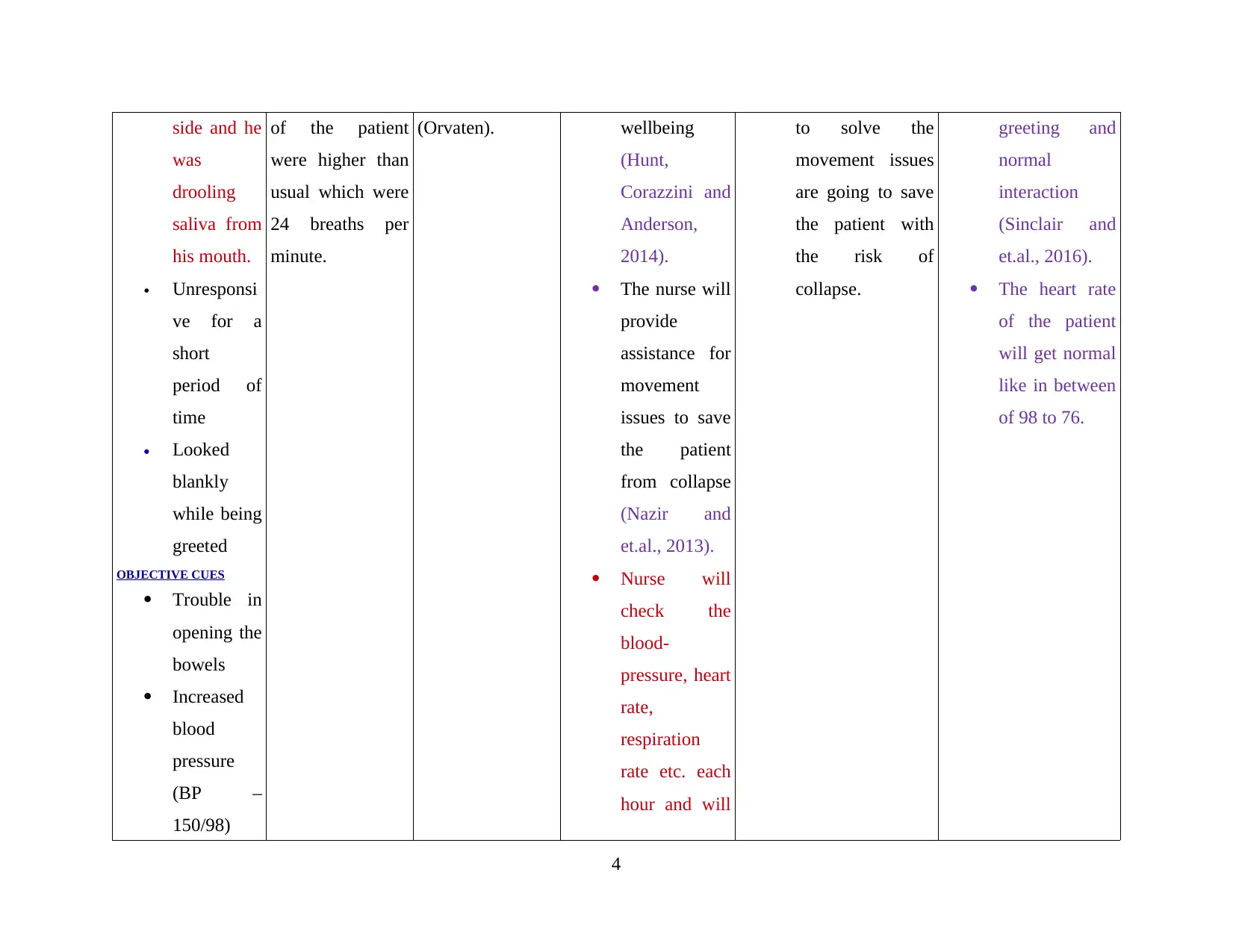
side and he
was
drooling
saliva from
his mouth.
Unresponsi
ve for a
short
period of
time
Looked
blankly
while being
greeted
OBJECTIVE CUES
Trouble in
opening the
bowels
Increased
blood
pressure
(BP –
150/98)
of the patient
were higher than
usual which were
24 breaths per
minute.
(Orvaten). wellbeing
(Hunt,
Corazzini and
Anderson,
2014).
The nurse will
provide
assistance for
movement
issues to save
the patient
from collapse
(Nazir and
et.al., 2013).
Nurse will
check the
blood-
pressure, heart
rate,
respiration
rate etc. each
hour and will
to solve the
movement issues
are going to save
the patient with
the risk of
collapse.
greeting and
normal
interaction
(Sinclair and
et.al., 2016).
The heart rate
of the patient
will get normal
like in between
of 98 to 76.
4
was
drooling
saliva from
his mouth.
Unresponsi
ve for a
short
period of
time
Looked
blankly
while being
greeted
OBJECTIVE CUES
Trouble in
opening the
bowels
Increased
blood
pressure
(BP –
150/98)
of the patient
were higher than
usual which were
24 breaths per
minute.
(Orvaten). wellbeing
(Hunt,
Corazzini and
Anderson,
2014).
The nurse will
provide
assistance for
movement
issues to save
the patient
from collapse
(Nazir and
et.al., 2013).
Nurse will
check the
blood-
pressure, heart
rate,
respiration
rate etc. each
hour and will
to solve the
movement issues
are going to save
the patient with
the risk of
collapse.
greeting and
normal
interaction
(Sinclair and
et.al., 2016).
The heart rate
of the patient
will get normal
like in between
of 98 to 76.
4
⊘ This is a preview!⊘
Do you want full access?
Subscribe today to unlock all pages.

Trusted by 1+ million students worldwide
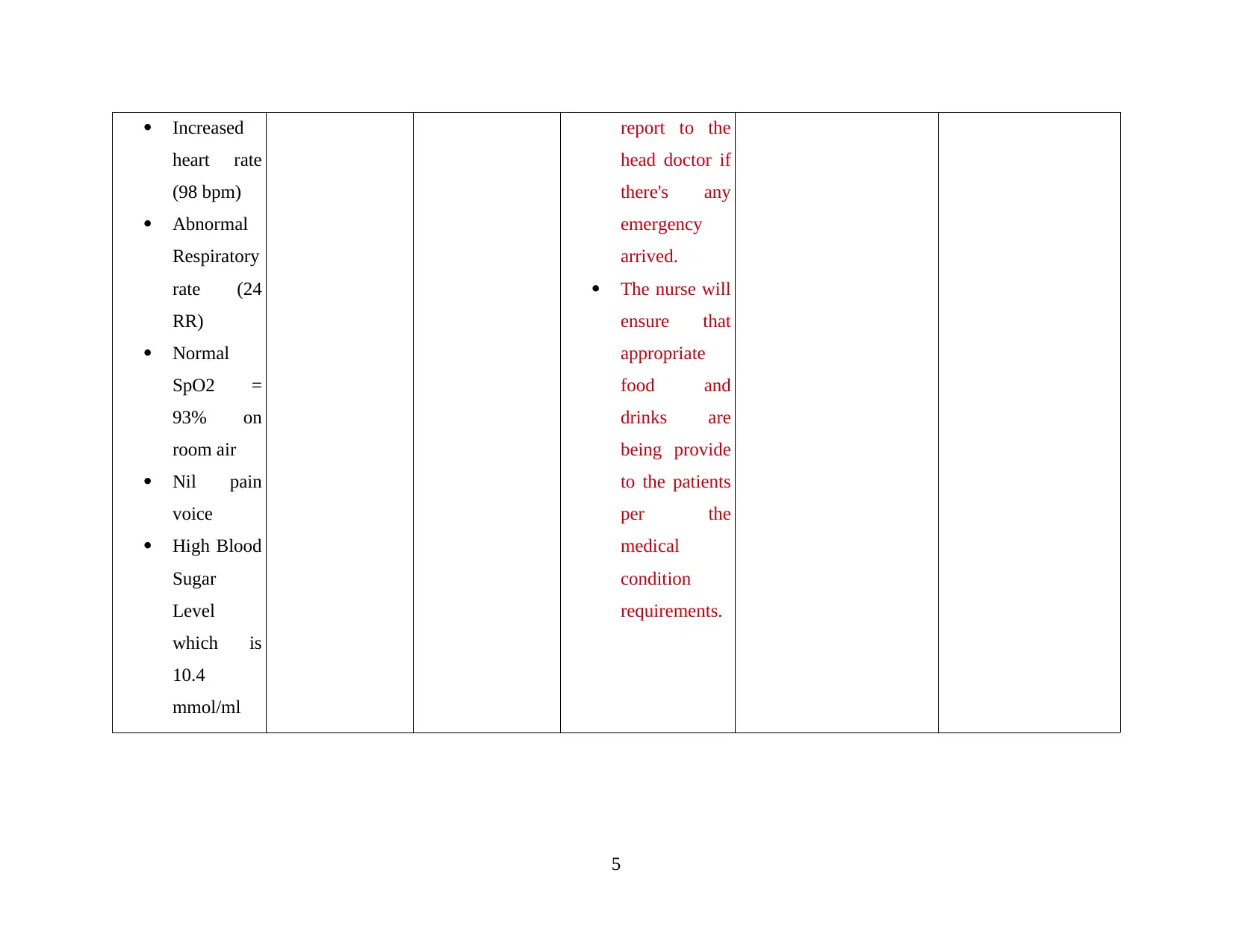
Increased
heart rate
(98 bpm)
Abnormal
Respiratory
rate (24
RR)
Normal
SpO2 =
93% on
room air
Nil pain
voice
High Blood
Sugar
Level
which is
10.4
mmol/ml
report to the
head doctor if
there's any
emergency
arrived.
The nurse will
ensure that
appropriate
food and
drinks are
being provide
to the patients
per the
medical
condition
requirements.
5
heart rate
(98 bpm)
Abnormal
Respiratory
rate (24
RR)
Normal
SpO2 =
93% on
room air
Nil pain
voice
High Blood
Sugar
Level
which is
10.4
mmol/ml
report to the
head doctor if
there's any
emergency
arrived.
The nurse will
ensure that
appropriate
food and
drinks are
being provide
to the patients
per the
medical
condition
requirements.
5
Paraphrase This Document
Need a fresh take? Get an instant paraphrase of this document with our AI Paraphraser
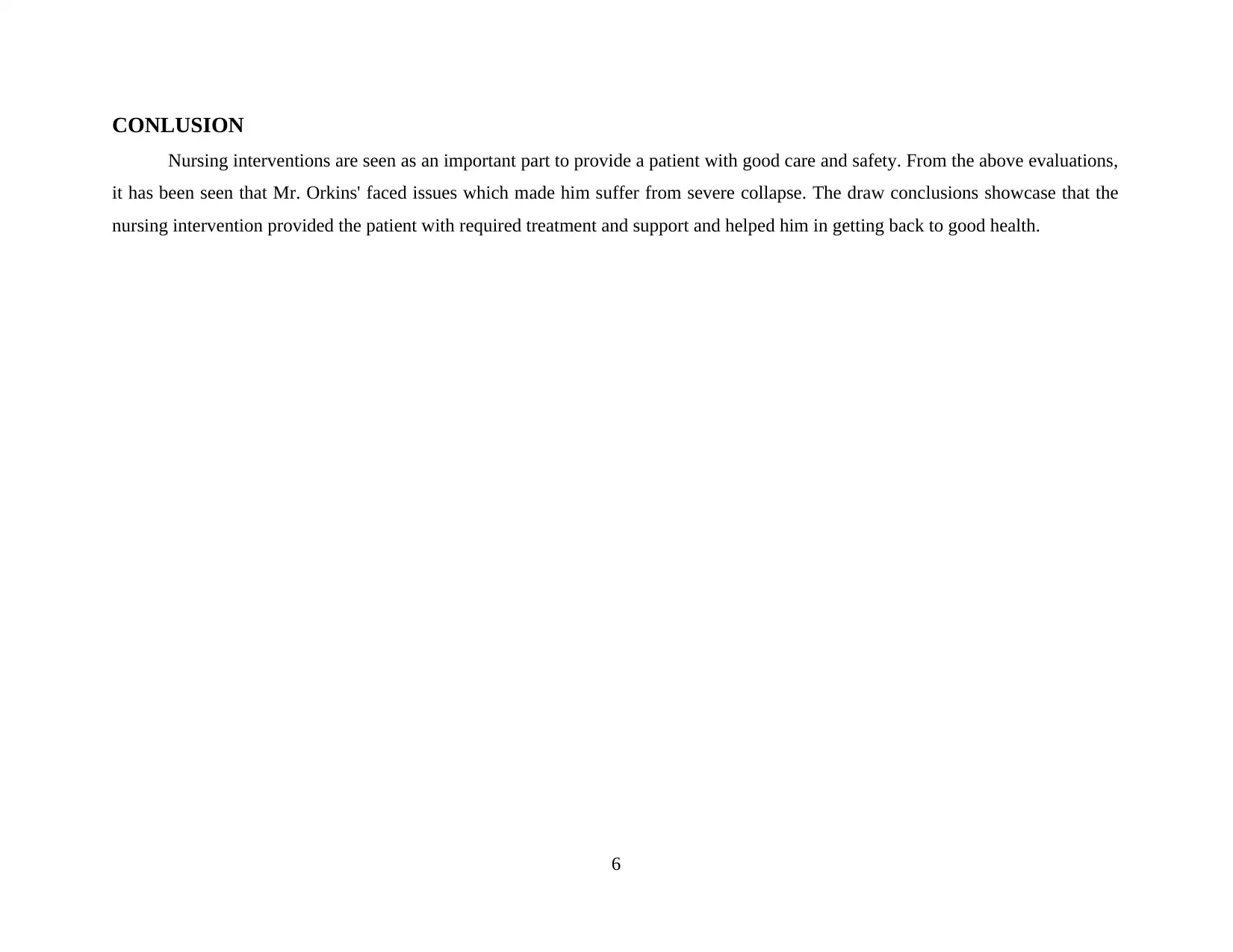
CONLUSION
Nursing interventions are seen as an important part to provide a patient with good care and safety. From the above evaluations,
it has been seen that Mr. Orkins' faced issues which made him suffer from severe collapse. The draw conclusions showcase that the
nursing intervention provided the patient with required treatment and support and helped him in getting back to good health.
6
Nursing interventions are seen as an important part to provide a patient with good care and safety. From the above evaluations,
it has been seen that Mr. Orkins' faced issues which made him suffer from severe collapse. The draw conclusions showcase that the
nursing intervention provided the patient with required treatment and support and helped him in getting back to good health.
6
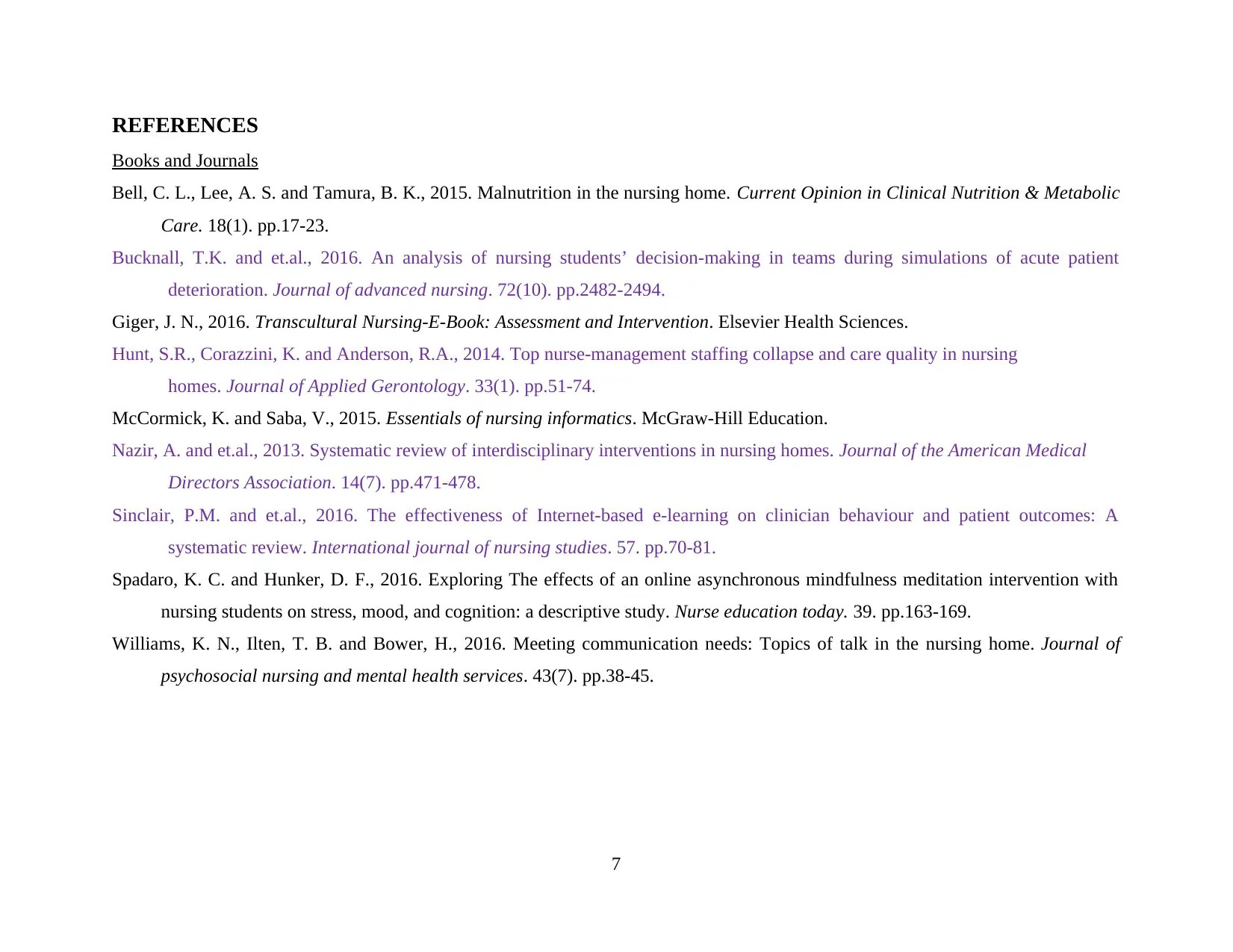
REFERENCES
Books and Journals
Bell, C. L., Lee, A. S. and Tamura, B. K., 2015. Malnutrition in the nursing home. Current Opinion in Clinical Nutrition & Metabolic
Care. 18(1). pp.17-23.
Bucknall, T.K. and et.al., 2016. An analysis of nursing students’ decision‐making in teams during simulations of acute patient
deterioration. Journal of advanced nursing. 72(10). pp.2482-2494.
Giger, J. N., 2016. Transcultural Nursing-E-Book: Assessment and Intervention. Elsevier Health Sciences.
Hunt, S.R., Corazzini, K. and Anderson, R.A., 2014. Top nurse-management staffing collapse and care quality in nursing
homes. Journal of Applied Gerontology. 33(1). pp.51-74.
McCormick, K. and Saba, V., 2015. Essentials of nursing informatics. McGraw-Hill Education.
Nazir, A. and et.al., 2013. Systematic review of interdisciplinary interventions in nursing homes. Journal of the American Medical
Directors Association. 14(7). pp.471-478.
Sinclair, P.M. and et.al., 2016. The effectiveness of Internet-based e-learning on clinician behaviour and patient outcomes: A
systematic review. International journal of nursing studies. 57. pp.70-81.
Spadaro, K. C. and Hunker, D. F., 2016. Exploring The effects of an online asynchronous mindfulness meditation intervention with
nursing students on stress, mood, and cognition: a descriptive study. Nurse education today. 39. pp.163-169.
Williams, K. N., Ilten, T. B. and Bower, H., 2016. Meeting communication needs: Topics of talk in the nursing home. Journal of
psychosocial nursing and mental health services. 43(7). pp.38-45.
7
Books and Journals
Bell, C. L., Lee, A. S. and Tamura, B. K., 2015. Malnutrition in the nursing home. Current Opinion in Clinical Nutrition & Metabolic
Care. 18(1). pp.17-23.
Bucknall, T.K. and et.al., 2016. An analysis of nursing students’ decision‐making in teams during simulations of acute patient
deterioration. Journal of advanced nursing. 72(10). pp.2482-2494.
Giger, J. N., 2016. Transcultural Nursing-E-Book: Assessment and Intervention. Elsevier Health Sciences.
Hunt, S.R., Corazzini, K. and Anderson, R.A., 2014. Top nurse-management staffing collapse and care quality in nursing
homes. Journal of Applied Gerontology. 33(1). pp.51-74.
McCormick, K. and Saba, V., 2015. Essentials of nursing informatics. McGraw-Hill Education.
Nazir, A. and et.al., 2013. Systematic review of interdisciplinary interventions in nursing homes. Journal of the American Medical
Directors Association. 14(7). pp.471-478.
Sinclair, P.M. and et.al., 2016. The effectiveness of Internet-based e-learning on clinician behaviour and patient outcomes: A
systematic review. International journal of nursing studies. 57. pp.70-81.
Spadaro, K. C. and Hunker, D. F., 2016. Exploring The effects of an online asynchronous mindfulness meditation intervention with
nursing students on stress, mood, and cognition: a descriptive study. Nurse education today. 39. pp.163-169.
Williams, K. N., Ilten, T. B. and Bower, H., 2016. Meeting communication needs: Topics of talk in the nursing home. Journal of
psychosocial nursing and mental health services. 43(7). pp.38-45.
7
⊘ This is a preview!⊘
Do you want full access?
Subscribe today to unlock all pages.

Trusted by 1+ million students worldwide
1 out of 9
Related Documents
Your All-in-One AI-Powered Toolkit for Academic Success.
+13062052269
info@desklib.com
Available 24*7 on WhatsApp / Email
![[object Object]](/_next/static/media/star-bottom.7253800d.svg)
Unlock your academic potential
Copyright © 2020–2025 A2Z Services. All Rights Reserved. Developed and managed by ZUCOL.





